top of page

HYPERCORE IT SOLUTION
We are here to make Technology work for You!

Customer Portfolio

Company Portfolio
Completed Projects


AWS Landing Zone
A landing zone is a well-architected, multi-account AWS environment that is scalable and secure. This is a starting point from which your organization can quickly launch and deploy workloads and applications with confidence in your security and infrastructure environment. Building a landing zone involves technical and business decisions to be made across account structure, networking, security, and access management in accordance with your organization’s growth and business goals for the future.
Security controls – Different applications might have different security profiles, requiring different control policies and mechanisms around them. It’s easier to talk to an auditor and point to a single account hosting the Payment Card Industry (PCI) workload.
Isolation – An account is a unit of security protection. Potential risks and security threats should be contained within an account without affecting others. There could be different security needs that require you to isolate one account from one another, whether due to multiple teams or a different security profile.
Data isolation – Isolating data stores to an account limits the number of people that can access and manage that data store. This contains exposure to highly private data and helps with General Data Protection Regulation (GDPR) compliance.
Many teams – Different teams have their different responsibilities and resource needs. They should not over-step one another in the same account.
Business process – Different business units or products might have different purposes and processes. You should establish different accounts to serve business-specific needs.
Billing – An account is the only true way to separate items at a billing level, including things like transfer charges. Multiple accounts help separate items at a billing level across business units, functional teams, or individual users.
Limit allocation – Limits are per account. Separating workloads into different accounts prevents them from consuming limits or potentially overprovisioning resources and then preventing other applications from working as intended.
Security controls – Different applications might have different security profiles, requiring different control policies and mechanisms around them. It’s easier to talk to an auditor and point to a single account hosting the Payment Card Industry (PCI) workload.
Isolation – An account is a unit of security protection. Potential risks and security threats should be contained within an account without affecting others. There could be different security needs that require you to isolate one account from one another, whether due to multiple teams or a different security profile.
Data isolation – Isolating data stores to an account limits the number of people that can access and manage that data store. This contains exposure to highly private data and helps with General Data Protection Regulation (GDPR) compliance.
Many teams – Different teams have their different responsibilities and resource needs. They should not over-step one another in the same account.
Business process – Different business units or products might have different purposes and processes. You should establish different accounts to serve business-specific needs.
Billing – An account is the only true way to separate items at a billing level, including things like transfer charges. Multiple accounts help separate items at a billing level across business units, functional teams, or individual users.
Limit allocation – Limits are per account. Separating workloads into different accounts prevents them from consuming limits or potentially overprovisioning resources and then preventing other applications from working as intended.


Router, Swicth & Server Installation/Turn up
• Designing and implementing new network solutions and/or improving the efficiency of current networks
• Installing, configuring, and supporting network equipment including routers, proxy servers, switches, WAN accelerators, DNS, and DHCP
• Procuring network equipment and managing subcontractors involved with network installation
• Configuring firewalls, routing, and switching to maximize network efficiency and security
• Maximizing network performance through ongoing monitoring and troubleshooting
• Arranging scheduled upgrades
• Investigating faults in the network
• Updating network equipment to the latest firmware releases
• Reporting network status to key stakeholders
• Installing, configuring, and supporting network equipment including routers, proxy servers, switches, WAN accelerators, DNS, and DHCP
• Procuring network equipment and managing subcontractors involved with network installation
• Configuring firewalls, routing, and switching to maximize network efficiency and security
• Maximizing network performance through ongoing monitoring and troubleshooting
• Arranging scheduled upgrades
• Investigating faults in the network
• Updating network equipment to the latest firmware releases
• Reporting network status to key stakeholders


3 Tier Web Application
A 3-tier application architecture is a modular client-server architecture that consists of a presentation tier, an application tier and a data tier. The data tier stores information, the application tier handles logic and the presentation tier is a graphical user interface (GUI) that communicates with the other two tiers. The three tiers are logical, not physical, and may or may not run on the same physical server.


Data center Migration
A data center migration into the cloud is often a daunting business initiative that can take years as you transition your existing hardware, software, networking, and operations into a brand new environment. In our roles having partnered with multiple cloud Professional Services & organization, we work side by side with customers to collaboratively architect and enable data center migrations into the Cloud. Over the years, we’ve participated in multiple migration journeys, and devised a general approach. Along the way, we’ve stumbled across a lot of complexities and learned a lot of lessons.
bottom of page